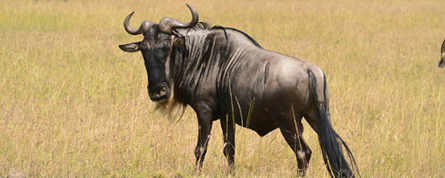

 Day 1 | ||||||||||||||||||||||||
 | ||||||||||||||||||||||||
| ||||||||||||||||||||||||
|
| ||||||||||||||||||||||||
Arusha - Lake ManyaraAfter breakfast, departure from Arusha towards Lake Manyara National Park. From Arusha it takes about 2 hours (110km) to reach the entrance to Lake Manyara National Park. Check-in to the park takes place from the small rural town of Mto-wa-Mbu (the name means "mosquito river"), which is surrounded by a fertile agricultural district with large orchards. Lake Manyara is located along Great Rift Valley, formed 20 million years ago, which extends 6400 km from the Dead Sea to the Kalahari Desert in Botswana. The park is very beautiful with wooded hilly terrain along the Great Rift Valley and houses expansive beach meadows facing the bird lake attraction. No less than about 400 bird species have been observed and sometimes the lake is invaded by thousands of pink shimmering smaller flamingos. | ||||||||||||||||||||||||
Day 2 | ||||||||||||||||||||||||
Lake Manyara - SerengetiDeparture towards Serengeti National Park. From Lake Manyara it takes about 1 hours to reach the entrance to Ngorongoro Conservation Area. Thereafter, the journey continues for about 2 hours through the Ngorongoro Conservation Area before reaching the Serengeti National Park. After crossing the park entrance at Naabi Hill, there is opportunity for game viewing along the way up to the accommodation in Serengeti. | ||||||||||||||||||||||||
Day 3 - Day 4 | ||||||||||||||||||||||||
 | ||||||||||||||||||||||||
| ||||||||||||||||||||||||
|
| ||||||||||||||||||||||||
Serengeti National ParkYta: 14800 km² Serengeti National Park is the world's most famous national park. From the park center Naabi Gate, the distance is 60 km up to Seronera, the center of the park, where most of the park's accommodations are located (320 km west of Arusha). Southern Serengeti is characterized by extensive savanna, while nature is more diverse around Seronera with elements of water systems, trees, hills and mountains. Through the Serengeti, the annual weather-controlled walking cycle "The great migration" takes place over a distance of about 2000 km of 2 million animals. Serengeti is the park where the biggest chance is to experience "the big five". | ||||||||||||||||||||||||
Day 5 | ||||||||||||||||||||||||
 | ||||||||||||||||||||||||
| ||||||||||||||||||||||||
|
| ||||||||||||||||||||||||
Serengeti - Ngorongoro Conservation AreaAfter lunch, return back from Serengeti towards the Ngorongoro Conservation Area with animal sighting along the route. From Seronera it takes about 3 hours to reach the Ngorongoro Crater. | ||||||||||||||||||||||||
Day 6 - Day 7 | ||||||||||||||||||||||||
 | ||||||||||||||||||||||||
| ||||||||||||||||||||||||
|
| ||||||||||||||||||||||||
Ngorongoro CraterArea: 304 km² Ngorongoro Conservation Area (8350 km²) is located 50 km west of Lake Manyara. Ngorongoro Conservation Area is the most spectacular tourist destination in Africa with fairytale nature and unforgettable wildlife experiences. Ngorongoro is a nature reserve and lacks national park status because of the nomad people Maasais who live here with their cattle herds. In the Ngorongoro reserve there are nine different craters, the most famous is Ngorongoro crater. This is the sixth largest caldera (collapsed volcano in the world) and measures 21 km in east-west direction and 18 km in north-south direction. The rim is at 2200 – 2400 m above sea level while the crater bottom is at 1700 – 1800 m altitude. Dry time extends from June to October, which is the best period for animal watching.Ngorongoro-reservatet (8350 km²) ligger 50 km väster om Lake Manyara. | ||||||||||||||||||||||||
 Day 8 | ||||||||||||||||||||||||
 | ||||||||||||||||||||||||
| ||||||||||||||||||||||||
|
| ||||||||||||||||||||||||
Tarangire National ParkArea: 2850 km² Tarangire National Park is located 50 km south of Lake Manyara National Park. The nature is varied in Tarangire with palm forest, tree and grassy savannas, cliffs and hilly terrain. The park is known for its characteristic baobab trees which grow up to 15 meters high. Without the existence of the Tarangire River, this park would not house much wildlife. The park is one of the most abundant national parks in Tanzania for birds (in terms of number of species). Tarangire is the elephant densest national park in Africa with about 2,000 elephants during September – December. During the months of January - March, zebras and wildbeest give birth to their calves annually. |